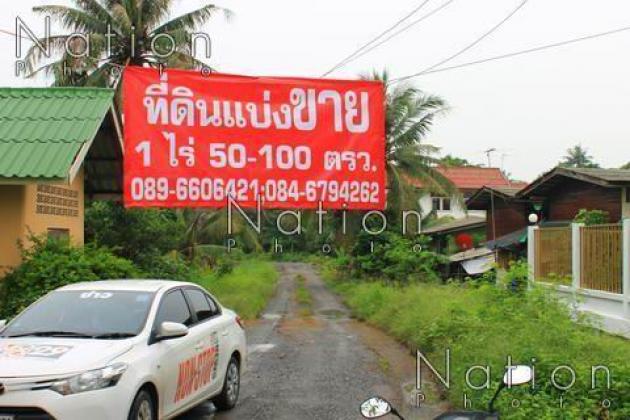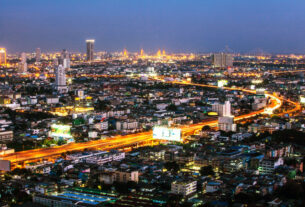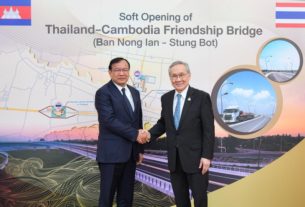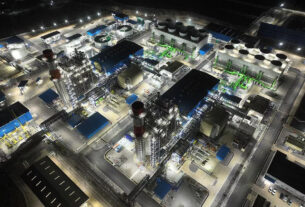
A land owner in Bang Krachao in Samut Prakan put up this sign to sell his plot. Signs like this are more frequently seen in Bang Krachao as the land price rises.
As more sell agricultural land in Bang Krachao, groups promote eco-tourism
THE AGRICULTURAL image of Samut Prakan’s Bang Krachao area is set for a radical change as more lands are being sold to property developers, forcing activist groups to encourage development of the area as an eco-tourism spot so as to protect the green lung of Bangkok.
Bang Krachao, the preserved green area south of Bangkok in Samut Prakan’s Phra Pradaeng district, is threatened by rapid urbanisation because of its ideal location just across the river from the capital’s bustling business districts of Yan Nava, Klong Toei and Bang Na. As a result, investors sense great prospects for real estate development.
Phongsak Taewtuean, a coconut farmer and the last coconut sugar producer in the area, disclosed that his rented coconut farm had been sold to a property developer by his landlord to build an urbanised village.
“I will have to move out from this land soon, as my landlord has already sold this coconut farm for a high price. I cannot grow more coconut trees and most of the coconut farms in the area have already vanished,” Phongsak said.
As the price of land in the Bang Krachao area has been increasing fast in recent years and the change in the city plan allows housing development in former green agricultural areas, many orchards have been neglected. In some places, the land was being graded to prepare for construction.
Phongsak revealed that the price of land on the main road was a minimum of Bt50,000 per four square metres and the cost of riverside land was as high as Bt1 million per rai, a steep jump from the Bt5,000 to Bt8,000 per four square metres a decade ago. As his rented land had been sold, he and his family have to move to a nearby plot. He insisted that he would carry on with coconut sugar production but he realises that it will be much harder for him to find the coconut nectar source
Jakkaphan Thruadmarakha, Big Tree Project campaigner and also a Bang Krachao local, attributed the change in the people’s lifestyle and the pressure from both outside and inside for more housing development as factors behind the developments.
“Many people don’t see the value of their agricultural identity and the surrounding green environment anymore, so they sell the land and live the urban life in Bangkok. This has combined with population growth in the area and the outside need for housing projects near Bangkok. Therefore, we have seen the gradual decrease in green space in Bang Krachao,” Jakkaphan said.
In order to protect the green lung of Bangkok, The Centre for People and Forests, Big Trees Project, and Rak Kung Bang Krachao group have introduced community-led eco-tourism to encourage people to protect the local identity and to push Bang Krachao as an eco-friendly tourism spot.
“The project is intended to let the local people learn to use their resources to promote eco-tourism, which will not only generate more income for the people but also raise awareness among the locals to love and protect their hometown, their heritage and the green space,” he said.
Source: http://www.nationmultimedia.com/national/Bangkoks-green-lung-slowly-being-eaten-away-30271135.html



